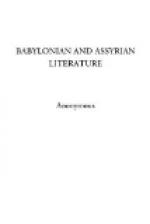BABYLONIAN PRIVATE CONTRACTS
THE STONE OF ZA’ALEH
This document, engraved on a small broken slab of basalt, is dated from the first year of the reign of Marduk-idin-akhe. It was discovered long ago in the small mound of Za’aleh, on the left bank of the Euphrates, a few miles northwest of Babylon. The text forms two columns of cursive Babylonian characters; the first column is extremely damaged. Though defaced, this contract offers some interest by its differing from other documents of the aforesaid reign. It has been published in the first volume of the collection of the British Museum ("W.A.I.,” pl. 66), and translated for the first time by Dr. Oppert, “Expedition en Mesopotamie” t. i, p. 253.
COLUMN I
Covenant which in the town of Babylon, in the month Sebat, in the first year of Marduk-idin-akhe, the mighty King, the men of M ..., have agreed:
The waters of the river ...,[1] and the waters of the canals did not go through....[2]
[Footnote 1: Lacuna.]
[Footnote 2: Lacuna of several lines.]
COLUMN II
....[1] and all the streams which exist at the mouth of the river Salmani. Therefore, Aradsu, son of Erisnunak, has agreed to (aforesaid things) for the times to come, in giving his signature to this tablet.
Bit-Karra-basa, son of Hea-habal-idin, Governor of the town of Isin; Babilayu, son of Sin-mustesir, Chief; Malik-akh-idinna, son of Nigazi, Chief of the ru-bar;[2] Tab-asap-Marduk, son of Ina-e-saggatu-irbu, a Scribe; Zikar-Nana, son of ...[1] Bin, sabil; Nabu-mumaddid-zir, a servant, son of Zikar-Ea, a Governor; and Nabu-idin-akhe, son of Namri, have fixed it in the furnitures of the house.
In the town of Babylon, on the 30th of Sebat (January), in the first year of Marduk-idin-akhe, the mighty King.
The Masters of the Royal Seal have granted approbation.
[Footnote 1: Lacuna of several lines.]
[Footnote 2: Unknown dignity.]
THE PARIS MICHAUX STONE
This monument is so called from the name of the traveller by whom it was brought over to France in 1800. It was discovered near the Tigris, not far from the ruins of the ancient city of Ctesiphon. It is an ovoid basalt stone of seventeen inches in height, by twenty-four in circumference. The upper part is decorated with symbolical figures spread over nearly one-third of the monument; one of the sides is divided in two parts. At the top the moon crescent and the sun are represented; in a somewhat lower place there are four altars; two on the right support tiaras; the other two are adorned with two symbolical figures. In the middle a winged goat kneeling; the lower part of the animal is hidden by the image of another altar.




